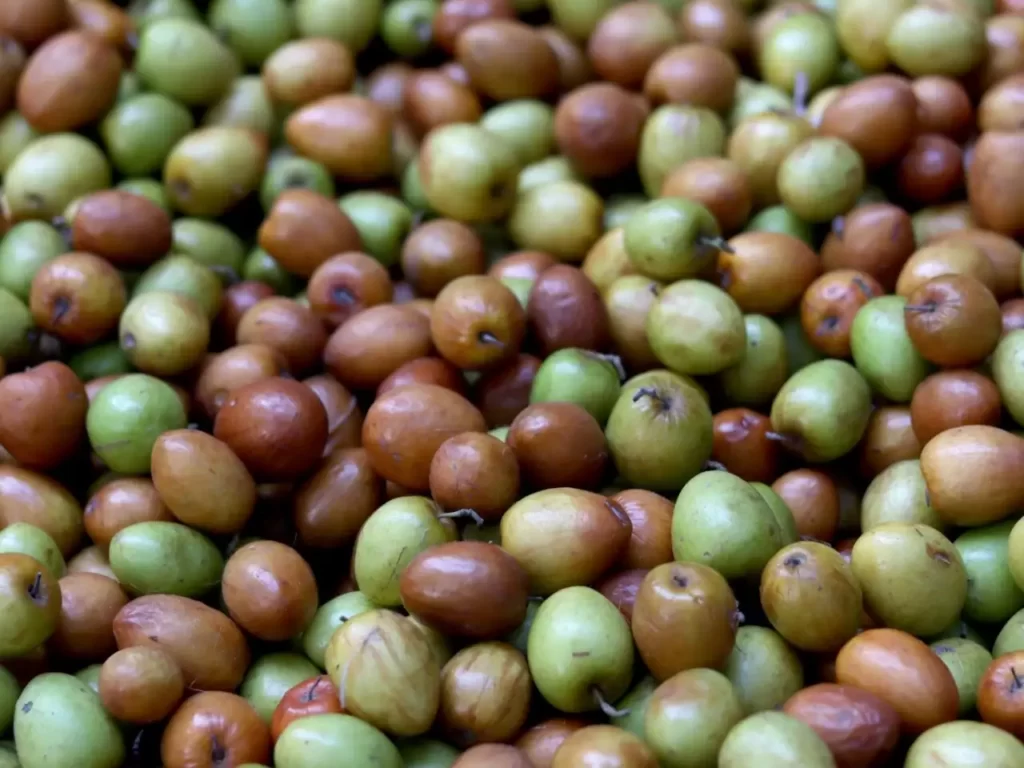Jujube Fruit Facts,FAQs, Behaviour, Habitat, Conservation and more

Jujube Fruit Facts | Description | Distribution and Habitat | Botany and evolution | Cultivation | Uses | Cultural | Interesting facts | frequently asked questions about Jujube Fruit
Fruit Jujube, also known as red date, is a small, nutrient-dense fruit that packs a punch of sweetness and nutrition. This fruit is native to China and has been used for centuries in traditional medicine for its various health benefits. With its unique taste and texture, jujubes are quickly gaining popularity around the world as a healthy snack or ingredient in recipes.
Taxonomy of Jujube Fruit
| Kingdom | Plantae |
|---|---|
| Subkingdom | Tracheobionta |
| Superdivision | Spermatophyta |
| Division | Magnoliophyta |
| Class | Magnoliopsida |
| Subclass | Rosidae |
| Order | Rhamnales |
| Family | Rhamnaceae |
| Genus | Ziziphus |
| Species | Z. jujuba |
Morphology of Jujube Fruit
| Morphological Characteristics | Description |
|---|---|
| Size | 1-2 inches in length, oval or pear-shaped |
| Color | Brownish-red to purplish-black when ripe, yellow when unripe |
| Skin | Thin, smooth, and edible |
| Flesh | White, crispy, and juicy |
| Seed | Small, oval-shaped, hard, and indigestible |
| Taste | Sweet, tangy, and slightly sour |
| Smell | Mild and pleasant |
| Texture | Firm and chewy |

Description of Jujube Fruit
Fruit Jujube, also known as Chinese date, is a small, deciduous tree native to China. It is cultivated for its sweet, edible fruit, which has a reddish-brown to dark brown color and a firm, chewy texture. The fruit is rich in vitamins, minerals, and antioxidants, making it a healthy snack or ingredient in recipes. Jujubes have been used in traditional medicine for their various health benefits, including boosting the immune system, improving digestion, and reducing stress and anxiety.
Distribution and habitat of Jujube Fruit
Fruit Jujube is native to China, but it is now grown in many other countries, including Korea, Japan, and the United States. It thrives in warm, dry climates and can tolerate drought and extreme temperatures. Jujube trees prefer well-drained soil and full sun, and they are often found in orchards or gardens. In the wild, jujubes can be found growing in rocky hillsides or along riverbanks.
Botany and evolution of Jujube Fruit
Fruit Jujube belongs to the family Rhamnaceae and is scientifically known as Ziziphus jujuba. It is a deciduous tree that can grow up to 10 meters tall and has a grayish-brown bark. The leaves of the tree are green, oval-shaped, and have a shiny surface. The fruit of the jujube tree is a drupe, which means it has a fleshy outer layer and a hard inner layer. The fruit has been cultivated in China for over 4,000 years and has a long history of use in traditional Chinese medicine.
Cultivation of Jujube Fruit
Fruit Jujube trees can be grown in a wide range of climates and soil types, but they prefer warm, dry conditions. The tree requires full sun and well-drained soil for optimal growth. Jujube trees can be propagated from seeds or cuttings, but grafting is the most common method used by growers. Once established, the tree requires minimal maintenance and is relatively resistant to pests and diseases. Fruit Jujubes are harvested in late summer or early fall when they are fully ripe and have a deep, reddish-brown color.
Uses of Jujube Fruit
Fruit Jujubes are commonly consumed fresh or dried and are used in a variety of recipes. They can be eaten as a snack or added to trail mixes, baked goods, and other dishes. The fruit is also used in traditional Chinese medicine to treat a range of health conditions, including insomnia, anxiety, and digestive issues. Jujube extracts and supplements are also available for those who wish to incorporate the fruit’s health benefits into their daily routine.
Cultural and Historical Significance of Jujube Fruit
Fruit Jujubes have a long history of use in traditional Chinese medicine and are considered to be one of the 50 fundamental herbs in Chinese herbal medicine. The fruit has also played a significant role in Chinese culture and mythology. In ancient times, the jujube tree was believed to have magical properties, and the fruit was used to ward off evil spirits and promote good luck. Today, Fruit Jujubes are widely cultivated and enjoyed around the world, and are known for their unique taste and health benefits.
Explanatory Notes for Jujube Fruit
Fruit Jujube is a nutrient-dense fruit that is high in vitamins, minerals, and antioxidants. It is a good source of fiber, which can help regulate digestion and reduce the risk of certain diseases. Jujubes are also low in calories and fat, making them a healthy snack option. However, jujubes are high in sugar, so they should be consumed in moderation. Jujubes may also interact with certain medications, so it is important to consult with a healthcare provider before using them as a supplement.
Interesting facts about Jujube Fruit
- Jujubes are believed to have originated in China over 4,000 years ago.
- In Chinese culture, jujubes are often given as gifts during the Lunar New Year for good luck and fortune.
- Jujubes have been used in traditional Chinese medicine to improve digestion and reduce stress and anxiety.
- Jujubes are also used in skincare products for their antioxidant and anti-inflammatory properties.
- Jujube trees can survive in a range of soil types and are drought-tolerant.
- Jujube fruit is high in vitamins, minerals, and antioxidants, but also high in sugar.
- Jujubes can be eaten fresh, dried, or used in recipes for desserts, jams, and sauces.
- Jujube seeds are used in traditional Chinese medicine as a sedative and as a remedy for coughs and sore throats.
- Jujubes have been used in other cultures, such as in India, where they are believed to have medicinal properties.
- The jujube fruit is also known as the Chinese date.
General queries or frequently asked questions about Jujube Fruit
Q: Are jujubes high in sugar?
A: Yes, jujubes are high in sugar, so they should be consumed in moderation.
Q: Are jujubes a good source of fiber?
A: Yes, jujubes are a good source of fiber, which can help regulate digestion and reduce the risk of certain diseases.
Q: Can jujubes be eaten fresh?
A: Yes, jujubes can be eaten fresh, and they can also be dried or used in recipes.
Q: What are the health benefits of jujubes?
A: Jujubes are high in vitamins, minerals, and antioxidants, and they are believed to have benefits for digestion, stress and anxiety, and skin health.
Q: Can jujubes be used in skincare products?
A: Yes, jujubes are used in skincare products for their antioxidant and anti-inflammatory properties.
Conclusion
Fruit Jujube is a versatile fruit with a rich history in traditional Chinese medicine and cuisine. It is high in vitamins, minerals, and antioxidants and can be eaten fresh, dried, or used in recipes. Jujubes are also used in skincare products for their antioxidant and anti-inflammatory properties. Jujube trees are hardy and easy to grow, and they are drought-tolerant and can survive in a range of soil types. However, jujubes are high in sugar and should be consumed in moderation. Overall, jujubes are a unique and nutritious fruit with a long and interesting history.












